Portal:Poetry/Selected article
Usage
- Add a new article to the next available subpage.
- Update "max=" to new total for its {{Random portal component}} on the main page.
Articles
Selected article 1
Portal:Poetry/Selected article/1

Selected article 2
Portal:Poetry/Selected article/2

It describes how Sir Gawain, a knight of King Arthur's Round Table, accepts a challenge from a mysterious "Green Knight" who challenges any knight to strike him with his axe if he will take a return blow in a year and a day. Gawain accepts and beheads him with his blow, at which the Green Knight stands up, picks up his head and reminds Gawain of the appointed time. In his struggles to keep his bargain Gawain demonstrates chivalry and loyalty until his honour is called into question by a test involving Lady Bertilak, the lady of the Green Knight's castle.
The poem survives in a single manuscript, the Cotton Nero A.x., which also includes three religious narrative poems: Pearl, Purity and Patience. All are thought to have been written by the same unknown author, dubbed the "Pearl Poet" or "Gawain Poet", since all four are written in a North West Midland dialect of Middle English. (Full article...)
Selected article 3
Portal:Poetry/Selected article/3

Poe claimed to have written the poem very logically and methodically, intending to create a poem that would appeal to both critical and popular tastes, as he explained in his 1846 follow-up essay "The Philosophy of Composition". The poem was inspired in part by a talking raven in the novel Barnaby Rudge: A Tale of the Riots of 'Eighty by Charles Dickens. Poe borrows the complex rhythm and meter of Elizabeth Barrett's poem "Lady Geraldine's Courtship", and makes use of internal rhyme as well as alliteration throughout.
"The Raven" was first attributed to Poe in print in the New York Evening Mirror on January 29, 1845. Its publication made Poe widely popular in his lifetime, although it did not bring him much financial success. Soon reprinted, parodied, and illustrated, critical opinion is divided as to the poem's status, but it nevertheless remains one of the most famous poems ever written. (Full article...)
Selected article 4
Portal:Poetry/Selected article/4

"Ulysses" is a poem in blank verse by the Victorian poet Alfred, Lord Tennyson (1809–1892), written in 1833 and published in 1842 in his well-received second volume of poetry. An oft-quoted poem, it is popularly used to illustrate the dramatic monologue form. Facing old age, mythical hero Ulysses describes his discontent and restlessness upon returning to his kingdom, Ithaca, after his far-ranging travels. Despite his reunion with his wife Penelope and son Telemachus, Ulysses yearns to explore again.
The character of Ulysses (in Greek, Odysseus) has been explored widely in literature. The adventures of Odysseus were first recorded in Homer's Iliad and Odyssey (c. 800–700 BC), and Tennyson draws on Homer's narrative in the poem. Most critics, however, find that Tennyson's Ulysses recalls Dante's Ulisse in his Inferno (c. 1320). In Dante's re-telling, Ulisse is condemned to hell among the false counsellors, both for his pursuit of knowledge beyond human bounds and for his adventures in disregard of his family.
For much of this poem's history, readers viewed Ulysses as resolute and heroic, admiring him for his determination "To strive, to seek, to find, and not to yield". The view that Tennyson intended a heroic character is supported by his statements about the poem, and by the events in his life—the death of his closest friend—that prompted him to write it. In the twentieth century, some new interpretations of "Ulysses" highlighted potential ironies in the poem. They argued, for example, that Ulysses wishes to selfishly abandon his kingdom and family, and they questioned more positive assessments of Ulysses' character by demonstrating how he resembles flawed protagonists in earlier literature. (Full article...)
Selected article 5
Portal:Poetry/Selected article/5
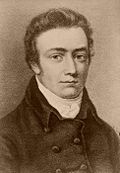
The conversation poems are a group of eight poems composed by Samuel Taylor Coleridge (1772–1834) between 1795 and 1807. Each details a particular life experience which lead to the poet's examination of nature and the role of poetry. They describe virtuous conduct and man's obligation to God, nature and society, and ask as if there is a place for simple appreciation of nature without having to actively dedicate one's life to altruism.
The Conversation poems were grouped in the 20th-century by literary critics who found similarity in focus, style and content. The series title was devised to describe verse where Coleridge incorporates conversational language while examining higher ideas of nature and morality. The works are held together by common themes, in particular they share meditations on nature and man's place in the universe. In each, Coleridge explores his idea of "One Life", a belief that people are spiritually connected through a universal relationship with God that joins all natural beings.
Critics have disagreed on which poem in the group is strongest. Frost at Midnight is usually held in high esteem, while Fears in Solitude is generally less well regarded.. (Full article...)
Selected article 6
Portal:Poetry/Selected article/6
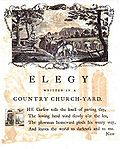
Elegy Written in a Country Churchyard is a poem by Thomas Gray, completed in 1750 and first published in 1751. The poem’s origins are unknown, but it was partly inspired by Gray’s thoughts following the death of the poet Richard West in 1742. Originally titled Stanza's Wrote in a Country Church-Yard, the poem was completed when Gray was living near St Giles' parish church at Stoke Poges. It was sent to his friend Horace Walpole, who popularised the poem among London literary circles. Gray was eventually forced to publish the work on 15 February 1751, to pre-empt a magazine publisher from printing an unlicensed copy of the poem.
The poem is an elegy in name but not in form; it employs a style similar to that of contemporary odes, but it embodies a meditation on death, and remembrance after death. The poem argues that the remembrance can be good and bad, and the narrator finds comfort in pondering the lives of the obscure rustics buried in the churchyard. The two versions of the poem, Stanzas and Elegy, approach death differently; the first contains a stoic response to death, but the final version contains an epitaph which serves to repress the narrator's fear of dying. With its discussion of, and focus on, the obscure and the known, the poem has possible political ramifications, but it does not make any definite claims on politics to be more universal in its approach to life and death.
The poem quickly became popular. It was printed many times, translated into many languages, and praised by critics even after Gray's other poetry had fallen out of favour. Later critics tended to praise its language and universal aspects, but some felt the ending was unconvincing, failing to resolve the questions the poem raised; or that the poem did not do enough to present a political statement that would serve to help the obscure rustic poor who form its central image. (Full article...)
Selected article 7
Portal:Poetry/Selected article/7 Imagism was a movement in early 20th-century Anglo-American poetry that favored precision of imagery and clear, sharp language. It has been described as the most influential movement in English poetry since the activity of the Pre-Raphaelites. As a poetic style it gave Modernism its start in the early 20th century, and is considered to be the first organized Modernist literary movement in the English language. Imagism is sometimes viewed as 'a succession of creative moments' rather than any continuous or sustained period of development. René Taupin remarked that 'It is more accurate to consider Imagism not as a doctrine, nor even as a poetic school, but as the association of a few poets who were for a certain time in agreement on a small number of important principles'.
The Imagists rejected the sentiment and discursiveness typical of much Romantic and Victorian poetry, in contrast to their contemporaries, the Georgian poets, who were generally content to work within that tradition. Imagism called for a return to what were seen as more Classical values, such as directness of presentation and economy of language, as well as a willingness to experiment with non-traditional verse forms. Imagists use free verse. (Full article...)
Selected article 8
Portal:Poetry/Selected article/8
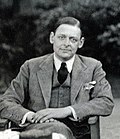
Four Quartets is a set of four poems written by T. S. Eliot that were published individually over a six-year period. The first poem, Burnt Norton, was written and published with a collection of his early works following the production of Eliot's play Murder in the Cathedral. After a few years, Eliot composed the other three poems, East Coker, The Dry Salvages, and Little Gidding, which were written during World War II and the air-raids on Great Britain. The poems were not collected until Eliot's New York publisher printed them together in 1943. They were first published as a series in Great Britain in 1944 towards the end of Eliot's poetic career.
Four Quartets are four interlinked meditations with the common theme being man's relationship with time, the universe, and the divine. In describing his understanding of the divine within the poems, Eliot blends his Anglo-Catholicism with mystical, philosophical and poetic works from both Eastern and Western religious and cultural traditions, with references to the Bhagavad-Gita and the Pre-Socratics as well as St. John of the Cross and Julian of Norwich.
Although many critics find the Four Quartets to be Eliot's great last work, some of Eliot's contemporary critics, including George Orwell, were dissatisfied with Eliot's overt religiosity. Later critics disagreed with Orwell's claims about the poems and argued instead that the religious themes made the poem stronger. Overall, reviews of the poem within Great Britain were favourable while reviews in the United States were split between those who liked Eliot's later style and others who felt he had abandoned positive aspects of his earlier poetry. (Full article...)
Selected article 9
Portal:Poetry/Selected article/9

"To Autumn" is a poem by English Romantic poet John Keats (31 October 1795 – 23 February 1821). The work was composed on 19 September 1819 and published in 1820 in a volume of Keats's poetry that included Lamia and The Eve of St. Agnes. "To Autumn" is the final work in a group of poems known as Keats's "1819 odes". Although personal problems left him little time to devote to poetry in 1819, he composed "To Autumn" after a walk near Winchester one autumnal evening. The work marks the end of his poetic career, as he needed to earn money and could no longer devote himself to the lifestyle of a poet. A little over a year following the publication of "To Autumn", Keats died in Rome.
The poem has three eleven-line stanzas which describe a progression through the season, from the late maturation of the crops to the harvest and to the last days of autumn when winter is nearing. The imagery is richly achieved through the personification of Autumn, and the description of its bounty, its sights and sounds. It has parallels in the work of English landscape artists, with Keats himself describing the fields of stubble that he saw on his walk as being like that in a painting.
The work has been interpreted as a meditation on death; as an allegory of artistic creation; as Keats's response to the Peterloo Massacre, which took place in the same year; and as an expression of nationalist sentiment. One of the most anthologised English lyric poems, "To Autumn" has been regarded by critics as one of the most perfect short poems in the English language. (Full article...)
Selected article 10
Portal:Poetry/Selected article/10
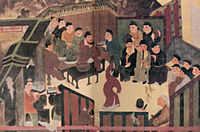
Fu (Chinese: 賦), variously translated as rhapsody or poetic exposition, is a form of Chinese rhymed prose that was the dominant literary form during the Han dynasty. Fu are poetic pieces in which an object, feeling, or subject is described and rhapsodized in exhaustive detail and from as many angles as possible. Classical fu composers attempted to use as wide a vocabulary as they could, and often included great numbers of rare and archaic terms in their compositions. Fu poems employ alternating rhyme and prose, varying line length, close alliteration, onomatopoeia, loose parallelism, and extensive cataloging of their topics.
Unlike the songs of the Classic of Poetry (Shijing) or the Verses of Chu (Chu ci), fu were meant to be recited aloud or chanted but not sung. The fu genre came into being around the 2nd and 3rd centuries BC and continued to be regularly used into the Song dynasty. Fu were used as grand praises for the imperial courts, palaces, and cities, but were also used to write "fu on things", in which any place, object, or feeling was rhapsodized in exhaustive detail. The largest collections of historical fu are the Selections of Refined Literature (Wen xuan), the Book of Han (Han shu), the New Songs from the Jade Terrace (Yutai xinyong), and official dynastic histories.
There is no counterpart or similar form to the fu genre in Western literature. During a large part of the twentieth century, fu poetry was harshly criticized by Chinese scholars as excessively ornate, lacking in real emotion, and ambiguous in its moral messages. Because of these historical associations, scholarship on fu poetry in China almost ceased entirely between 1949 and the end of the Cultural Revolution in 1976. Since then, study of fu has gradually returned to its previous level. (Full article...)
Selected article 11
Portal:Poetry/Selected article/11

The Aeneid (/ɪˈniːɪd/; Latin: Aeneis [ae̯ˈneːɪs]) is a Latin epic poem, written by Virgil between 29 and 19 BC, that tells the legendary story of Aeneas, a Trojan who travelled to Italy, where he became the ancestor of the Romans. It is composed of 9,896 lines in dactylic hexameter. The first six of the poem's twelve books tell the story of Aeneas's wanderings from Troy to Italy, and the poem's second half tells of the Trojans' ultimately victorious war upon the Latins, under whose name Aeneas and his Trojan followers are destined to be subsumed.
The hero Aeneas was already known to Greco-Roman legend and myth, having been a character in the Iliad, composed in the 8th century BC. Virgil took the disconnected tales of Aeneas's wanderings, his vague association with the foundation of Rome and a personage of no fixed characteristics other than a scrupulous pietas, and fashioned this into a compelling founding myth or national epic that at once tied Rome to the legends of Troy, explained the Punic wars, glorified traditional Roman virtues and legitimized the Julio-Claudian dynasty as descendants of the founders, heroes and gods of Rome and Troy. (Full article...)
Selected article 12
Portal:Poetry/Selected article/12

Beowulf (/ˈbeɪəwʊlf/, Old English: [ˈbeːowʊɫf]) is the conventional title of an Old English epic poem consisting of 3182 alliterative long lines, set in Scandinavia, the oldest surviving epic poem of Old English and thus commonly cited as one of the most important works of Anglo-Saxon literature, and also arguably the earliest vernacular English literature.
The full poem survives in the manuscript known as the Nowell Codex, located in the British Library. Written in England, its composition by an anonymous Anglo-Saxon poet is dated between the 8th and the early 11th century. In 1731, the manuscript was badly damaged by a fire that swept through Ashburnham House in London that had a collection of medieval manuscripts assembled by Sir Robert Bruce Cotton. The poem's existence for its first seven centuries or so made no impression on writers and scholars, and besides a brief mention in a 1705 catalogue by Humfrey Wanley it was not studied until the end of the 18th century, and not published in its entirety until Johan Bülow funded the 1815 Latin translation, prepared by the Icelandic-Danish scholar Grímur Jónsson Thorkelin. After a heated debate with Thorkelin, Bülow offered to support a new translation by N.F.S. Grundtvig — this time into Danish. The result, Bjovulfs Drape (1820), was the first modern language translation of Beowulf. (Full article...)
Selected article 13
Portal:Poetry/Selected article/13

On the surface, the poem describes Dante's travels through Hell, Purgatory, and Heaven; but at a deeper level, it represents, allegorically, the soul's journey towards God. At this deeper level, Dante draws on medieval Christian theology and philosophy, especially Thomistic philosophy and the Summa Theologica of Thomas Aquinas. Consequently, the Divine Comedy has been called "the Summa in verse". (Full article...)
Selected article 14
Portal:Poetry/Selected article/14

The first half of the story discusses Gilgamesh, king of Uruk, and Enkidu, a wild man created by the gods to stop him oppressing the people of Uruk. After an initial fight, Gilgamesh and Enkidu become close friends. Together, they journey to the Cedar Mountain and defeat Humbaba, its monstrous guardian. Later they kill the Bull of Heaven, which the goddess Ishtar sends to punish Gilgamesh for spurning her advances. As a punishment for these actions, the gods sentence Enkidu to death.
In the second half of the epic, Gilgamesh's distress at Enkidu's death causes him to undertake a long and perilous journey to discover the secret of eternal life. He eventually learns that "Life, which you look for, you will never find. For when the gods created man, they let death be his share, and life withheld in their own hands". However, because of his great building projects, his account of Siduri's advice, and what the immortal man Utnapishtim told him about the Great Flood, Gilgamesh's fame survived his death. His story has been translated into many languages, and in recent years has featured in works of popular fiction. (Full article...)
Selected article 15
Portal:Poetry/Selected article/15

Ginsberg began work on "Howl" as early as 1954. In the Paul Blackburn Tape Archive at the University of California, San Diego, Ginsberg can be heard reading early drafts of his poem to his fellow writing associates. "Howl" is considered to be one of the great works of American literature. It came to be associated with the group of writers known as the Beat Generation, which included Jack Kerouac and William S. Burroughs.
There is no foundation to the myth that "Howl" was written as a performance piece and later published by poet Lawrence Ferlinghetti of City Lights Books. This myth was perpetuated by Ferlinghetti as part of the defense's case during the poem's obscenity trial, as detailed below. Upon the poem's release, Ferlinghetti and the bookstore's manager, Shigeyoshi Murao, were charged with disseminating obscene literature, and both were arrested. On October 3, 1957, Judge Clayton W. Horn ruled that the poem was not obscene. (Full article...)
Selected article 16
Portal:Poetry/Selected article/16

Some of Coleridge's contemporaries denounced the poem and questioned his story about its origin. It was not until years later that critics began to openly admire the poem. Most modern critics now view Kubla Khan as one of Coleridge's three great poems, with The Rime of the Ancient Mariner and Christabel. The poem is considered one of the most famous examples of Romanticism in English poetry. A copy of the manuscript is a permanent exhibit at the British Museum in London. (Full article...)
Selected article 17
Portal:Poetry/Selected article/17
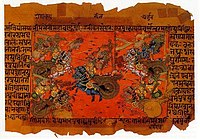
Besides its epic narrative of the Kurukshetra War and the fates of the Kaurava and the Pandava princes, the Mahabharata contains philosophical and devotional material, such as a discussion of the four "goals of life" or purusharthas (12.161). Among the principal works and stories in the Mahabharata are the Bhagavad Gita, the story of Damayanti, an abbreviated version of the Ramayana, and the Rishyasringa, often considered as works in their own right.
Traditionally, the authorship of the Mahabharata is attributed to Vyasa. There have been many attempts to unravel its historical growth and compositional layers. The oldest preserved parts of the text are thought to be not much older than around 400 BCE, though the origins of the epic probably fall between the 8th and 9th centuries BCE. The text probably reached its final form by the early Gupta period (c. 4th century CE). The title may be translated as "the great tale of the Bhārata dynasty". According to the Mahabharata itself, the tale is extended from a shorter version of 24,000 verses called simply Bhārata.
The Mahabharata is the longest known epic poem and has been described as "the longest poem ever written". Its longest version consists of over 100,000 shloka or over 200,000 individual verse lines (each shloka is a couplet), and long prose passages. About 1.8 million words in total, the Mahabharata is roughly ten times the length of the Iliad and the Odyssey combined, or about four times the length of the Ramayana. W. J. Johnson has compared the importance of the Mahabharata to world civilization to that of the Bible, the works of Shakespeare, the works of Homer, Greek drama, or the Qur'an. (Full article...)
Selected article 18
Portal:Poetry/Selected article/18

Verses in the Ramayana are written in a 32-syllable meter called anuṣṭubh. The Ramayana was an important influence on later Sanskrit poetry and Hindu life and culture. Like the Mahabharata, the Ramayana is not just a story: it presents the teachings of ancient Hindu sages (Vedas) in narrative allegory, interspersing philosophical and devotional elements. The characters Rama, Sita, Lakshman, Bharata, Hanuman, and Ravana are all fundamental to the cultural consciousness of India, Nepal, and many south-east Asian countries such as Thailand and Indonesia. (Full article...)
Selected article 19
Portal:Poetry/Selected article/19

Although meeting the criteria for an epic, the poem defies simple genre classification by its use of varying themes and tones. Ovid took inspiration from the genre of metamorphosis poetry, and some of the Metamorphoses derives from earlier treatment of the same myths; however, he diverged significantly from all of his models.
One of the most influential works in Western culture, the Metamorphoses has inspired such authors as Chaucer, Shakespeare, Dante and Boccaccio. Numerous episodes from the poem have been depicted in masterpieces of sculpture and painting by artists such as Titian. Although interest in Ovid faded after the Renaissance, towards the end of the twentieth century there was a resurgence of attention to his work; today, the Metamorphoses continues to inspire and be retold through various media. The work has been the subject of numerous translations into English, the first by William Caxton in 1480. (Full article...)
Selected article 20
Portal:Poetry/Selected article/20

A villanelle, also known as villanesque, is a nineteen-line poetic form consisting of five tercets followed by a quatrain. There are two refrains and two repeating rhymes, with the first and third lines of the first tercet repeated alternately at the end of each subsequent stanza until the last stanza, which includes both repeated lines. The villanelle is an example of a fixed verse form. The word derives from Latin, then Italian, and is related to the initial subject of the form being the pastoral.
The form started as a simple ballad-like song with no fixed form; this fixed quality would only come much later, from the poem "Villanelle (J'ay perdu ma Tourterelle)" (1606) by Jean Passerat. From this point, its evolution into the "fixed form" used in the present day is debated. Despite its French origins, the majority of villanelles have been written in English, a trend which began in the late nineteenth century. The villanelle has been noted as a form that frequently treats the subject of obsessions, and one which appeals to outsiders; its defining feature of repetition prevents it from having a conventional tone. (Full article...)
Selected article 21
Portal:Poetry/Selected article/21

Haiku (俳句, listen) is a type of short form poetry that originated in Japan. Traditional Japanese haiku consist of three phrases composed of 17 phonetic units (called on in Japanese, which are similar to syllables) in a 5, 7, 5 pattern; that include a kireji, or "cutting word"; and a kigo, or seasonal reference. Similar poems that do not adhere to these rules are generally classified as senryū.
Haiku originated as an opening part of a larger Japanese poem called renga. These haiku written as an opening stanza were known as hokku and over time they began to be written as stand-alone poems. Haiku was given its current name by the Japanese writer Masaoka Shiki at the end of the 19th century.
Originally from Japan, haiku today are written by authors worldwide. Haiku in English and haiku in other languages have different styles and traditions while still incorporating aspects of the traditional haiku form. Non-Japanese haiku vary widely on how closely they follow traditional elements. Additionally, a minority movement within modern Japanese haiku (現代俳句, gendai-haiku), supported by Ogiwara Seisensui and his disciples, has varied from the tradition of 17 on as well as taking nature as their subject. (Full article...)
